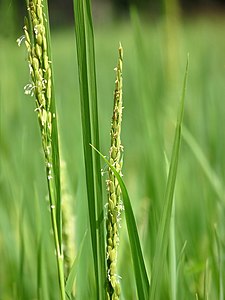Rice/ja: Difference between revisions
Created page with "=== 耐冷性 ===" Tags: Mobile edit Mobile web edit |
|||
| Line 362: | Line 362: | ||
=== 耐冷性 === | === 耐冷性 === | ||
コメは12℃以下の温度に敏感である。播種は、日平均気温が確実にこの上限を超える時期に行われる。それ以下の平均気温は生育を低下させ、4日以上持続すると、発芽や苗の生育が阻害され、苗が枯死することもある。冷害を受けた大株のイネでは、いもち病が促進され、収量が著しく減少する。2022年現在、研究者たちはイネの耐冷性のメカニズムとその遺伝的基盤について研究を続けている。 | |||
< | <span id="Reducing_methane_emissions"></span> | ||
=== | === メタン排出量削減 === | ||
[[:en:Paddy field|水田]]でのイネ生産は、[[Methanogen/ja|メタン生成菌]]によるメタン放出のため環境に有害である。これらの細菌は嫌気性の湛水土壌に生息し、イネの根から放出される栄養素を消費する。[[barley/ja|オオムギ]]の遺伝子''SUSIBA2''をイネに導入すると、バイオマス生産が根から茎へと変化し、メタン生成菌の個体数が減少し、メタン排出量が最大97%削減される。さらに、この改変によりコメの穀粒の量も増加する。 | |||
<div lang="en" dir="ltr" class="mw-content-ltr"> | <div lang="en" dir="ltr" class="mw-content-ltr"> | ||
Revision as of 12:58, 11 June 2025


米は穀物の一種であり、栽培された形態では、アジアやアフリカを中心に世界の人口の半分以上にとっての主食である。米は、イネ属の植物である稲(アジアイネ)の種子であり、ごく稀にアフリカ稲(アフリカイネ)の種子である。アジアイネは13,500年から8,200年前に中国で栽培化され、アフリカイネは約3,000年前にアフリカで栽培化された。米は世界中の多くの文化で一般的なものとなり、2023年には8億トンが生産され、サトウキビとトウモロコシに次ぐ第3位の生産量となっている。国際的に取引される米は、全体のわずか約8%に過ぎない。中国、インド、インドネシアが最大の米消費国である。発展途上国で生産される米の相当量が、劣悪な輸送や貯蔵などの要因により収穫後に失われている。米の収量は、昆虫、齧歯類、鳥類などの害虫や雑草、稲熱病などの病気によって減少する可能性がある。合鴨農法などの伝統的な稲作複合養殖や、現代の総合的病害虫管理は、持続可能な方法で害虫による被害を抑制しようとしている。
乾燥した米粒は外層を除去するために精米される。除去の度合いによって、玄米から胚芽米、白米まで様々な製品がある。一部は調理しやすくするためにパーボイルされる。米はグルテンを含まず、タンパク質を提供するが、健康に必要なすべての必須アミノ酸を供給するわけではない。世界中で様々な種類の米が食べられている。米粒中のデンプン成分であるアミロースとアミロペクチンの組成は、異なる食感特性を与える。インディカ栽培品種に由来する長粒米は、調理中に形を保ちやすく、乾燥していてふっくらしている傾向がある。バスマティやジャスミンのような香り米は、アジア料理で広く使われ、その強い香りとナッツのような風味で区別される。その品種には、カリフォルニア米産業を確立したカルローズ米、優れた調理特性から「イタリア米の王様」と称されるカルナローリ、そしてアントシアニン含有量が高いため濃い紫色に見え、古代中国では王族の食用に限定されていたことから「禁断の米」としても知られる黒米がある。主にジャポニカ栽培品種に由来する短粒米は、楕円形をしており、粘り気のある食感である。コシヒカリ、ハツシモ、ササニシキなど、日本の気候や地理の異なる地域に固有の米を使った寿司など、日本料理で多用されており、調理しても形を保つ。また、もち米を使ったもちのような甘い料理や、リゾット(アルボリオ米を使用)やパエリア(ボンバ米を使用。これは実際にはインディカ品種である)などのヨーロッパ料理にも使用される。炊いた白米には、29%の炭水化物と2%のタンパク質が含まれ、少量のマンガンも含まれる。ゴールデンライスは、遺伝子工学によってビタミンAを生成するように作られた品種である。
2022年には、米の生産が世界の温室効果ガス排出量の1%以上を引き起こしたと推定されている。気候変動が米の収量に与える影響の予測は、地域や社会経済状況によって異なる。人間文化において、米は結婚式など、様々な宗教や伝統で役割を果たしている。
特徴
米は高さ1メートル (3.3 ft)以上に生長する。深水の場合、長さ5メートル (16 ft)に達することがある。種まきから収穫まで約6ヶ月かかる。1つの植物には複数の葉の茂った茎、すなわち分げつがある場合がある。直立した茎は節があり、その長さに沿って節がある。各節からは長くて細い葉が生じる。自家受精性の花は穂(円錐花序)として生成され、これは茎の最後の節間から生じる分枝した花序である。1つの円錐花序には最大350個の小穂があり、それぞれに雄花と雌花の部分(葯と胚珠)が含まれる。受精した胚珠は食用になる穀粒、すなわち穎果に発展する。
米はPoaceae科に属する穀物である。熱帯作物として、十分な水が供給される限り、年間2つの異なる季節(乾季と雨季)に栽培できる。通常は一年生植物であるが、熱帯では多年生植物として生き残り、再生栽培で収穫できる
農学
成長
他の作物と同様に、米の生育は生物的および非生物的環境要因の両方に依存する。主要な生物的要因は品種、病害虫、および植物病である。非生物的要因には、土壌の種類、低地か畑か、降雨または灌漑水の量、温度、日長、および日照強度が含まれる。
米の種子は生育する畑に直接播種することもできるし、苗床で育てた苗を畑に移植することもできる。直播きは約60〜80kg/ヘクタールの種子を必要とするが、移植はそれより少なく、約40kg/ヘクタールで済むが、はるかに多くの労働力を必要とする。アジアのほとんどの稲作は手作業で移植されている。機械による移植は時間がかからないが、丁寧に準備された圃場と、機械に合うようにマットやトレイで育てられた苗が必要となる。米は継続的に水没させると生育が良くない。米は水の利用可能性に応じて、さまざまな環境で栽培できる。一般的な方法は、低地の田んぼを畦畔で囲み、収穫の約1週間前まで数センチメートルの深さに湛水することである。これは大量の水を必要とする。「交互湛水」技術は、より少ない水を使用する。この方法の一つは、田んぼを5 cm(2 in)の深さに湛水し、その後、土壌に埋め込まれた穴あき田んぼ用水チューブで測定して、水面が地表下15 cm(6 in)まで下がるのを待ってから、このサイクルを繰り返すというものである。深水稲の品種は、少なくとも1ヶ月間50センチメートルを超える深さの湛水に耐える。陸稲は、丘陵地や山岳地帯で湛水せずに栽培され、小麦やトウモロコシのように天水で栽培される。
収穫
アジア全域において、未精米の米、すなわち「籾」(インドネシア語・マレー語でpadi)は、伝統的に小規模農家による生産物であり、手作業で収穫されていた。大規模農家では、労働力の投入を減らすためにコンバインハーベスターなどの機械を利用している。穀物の水分含有量が20~25%になると、収穫準備が整う。収穫には、刈り取り、刈り取った茎の積み重ね、穀粒を分離するための脱穀、風選または篩い分けによる選別が含まれる。
進化
系統発生
食用となるイネの種は、イネ科(Poaceae)内のBOP cladeに属する。イネ亜科(Oryzoideae)は、タケ亜科(Bambusoideae)およびコムギ亜科(Pooideae)の姉妹群である。イネ属(Oryza)は、Oryzeae族の11属のうちの1つであり、Phyllorachideaeの姉妹群である。食用イネ種であるO. sativaとO. glaberrimaは、本属の約300種または亜種のうちの2つである。
| Poaceae |
| |||||||||||||||||||||||||||||||||||||||||||||||||||||||||
歴史
Oryza sativa米は、9,000年前に中国で栽培化されたのが最初であり、長江上流および下流の新石器時代文化の人々によって行われた。彼らはそれぞれモン・ミエン語族および前オーストロネシア語族と関連している。穀物の栽培化を示す決定的な指標である脱粒性に関する機能的対立遺伝子は、他の5つの一塩基多型と同様に、インディカとジャポニカの両方で同一である。このことは、O. sativaが単一の栽培化イベントを経たことを示唆している。アジア米のインディカとジャポニカの両形態は、中国で野生米Oryza rufipogonから単一の栽培化イベントを経て誕生した。この証拠にもかかわらず、インディカ米は、約4,500年前にジャポニカがインドに到達し、未栽培のプロトインディカまたは野生のO. nivaraのいずれかの別の米と交配して生じたようである。
米は、約6000〜5600年前には中国北部のシナ・チベット文化圏に、約5500〜3200年前には朝鮮半島と日本に早期に導入された。また、5500〜4000年前には大坌坑文化によって台湾にも伝わり、その後オーストロネシア人の拡散を通じて東南アジア島嶼部、マダガスカル、グアムへと南下したが、太平洋の他の地域への航海では生き残れなかった。東南アジア大陸部および中国南部では、5000年前までにオーストロアジア語族およびタイ・カダイ語族に到達した。
米は、栽培、移住、貿易を通じて世界の他の地域にも広がり、最終的には1492年以降のコロンブス交換の一部としてアメリカ大陸にも到達した。現在ではあまり一般的ではないOryza glaberrima(アフリカイネ)は、約3,000年前にアフリカで独立して栽培化され、スペイン人によってアメリカ大陸に導入された。アメリカ独立戦争が始まる頃のイギリス領北アメリカでは、米はタバコ、小麦、魚に次いで4番目に価値のある輸出品となっていた。
商業
| 米生産 – 2023 | |
|---|---|
| 国 | 百万トン |
| 207 | |
| 207 | |
| 59 | |
| 54 | |
| 43 | |
| 33 | |
| 世界 | 800 |
生産
2023年における世界のコメ生産量は8億トンであり、中国とインドが合わせて全体の52%を占めた。これにより、コメは生産量でサトウキビとトウモロコシに次ぐ3番目の作物となった。他の主要生産国にはバングラデシュ、インドネシア、ベトナムがあった。世界の生産量の90%はアジア産である。
-
コメの生産量(2021年)
-
2000年以降、コメの生産量(オレンジ色)は増加しているが、
作物総生産量に占める割合は減少している。
収量記録
2022年のコメの世界平均収量は4.7 metric tons per hectare (2.1 short tons per acre)であった。中国国立ハイブリッドライス研究開発センターの袁隆平は、1999年に実証区で17.1 metric tons per hectare (7.6 short tons per acre)というコメの収量世界記録を樹立した。これは、特別に開発されたハイブリッド米と、稲作における革新である米集中栽培システム(SRI)を用いたものである。
食料安全保障
コメはアジア、ラテンアメリカ、アフリカの一部地域で主要な主食であり、世界人口の半数以上に食料を供給している。しかし、非効率な輸送、貯蔵、精米によって、収穫後にかなりの量の作物が失われる可能性がある。ナイジェリアでは、収穫後に作物の4分の1が失われている。貯蔵損失には、コメが十分に乾燥されていない場合のカビによる損傷が含まれる。中国では、現代的な金属製サイロでの損失はわずか0.2%であったが、農家で貯蔵された場合は7〜13%であった。
加工
 米の加工では、商品となる製品を作るために、1つまたは複数の層が除去される。 | |
乾燥した穀粒は、籾殻や糠といった外層を除去するために精米される。これらは、1段階、2段階、あるいは商業的な精米のように、精選、籾すり、選別、精白、等級付け、計量といった多段階の工程で除去される。玄米は、食用に適さない籾殻だけが除去されている。さらに精米することで、糠と胚芽が除去され、段階的に白い製品が作られる。パーボイル米は、精米前に蒸気処理される。これにより穀粒が硬くなり、穀粒のビタミンやミネラルの一部が米の白い部分に移動するため、精米後もそれらが保持される。米にはグルテンが含まれていないため、グルテンフリーダイエットを行っている人にも適している。米はタンパク質の良い供給源であり、世界の多くの地域で主食とされているが、健康に必要な十分な量の必須アミノ酸をすべて含んでいないため、完全なタンパク質ではない。
貿易
世界の貿易量は生産量よりもはるかに少なく、生産された米の8%未満しか国際的に取引されていない。2000年代初頭には米の輸出国であった中国は、2013年までに世界最大の米輸入国となった。途上国が世界の米貿易の主要な担い手であり、2012年までにインドは最大の米輸出国となり、タイとベトナムがそれに続く主要輸出国であった。
世界的な消費
2016年時点で、最も米を消費していた国は中国(全体の29%)、インド、インドネシアであった。2020年までにバングラデシュがインドネシアから3位の座を奪った。2020年から2023年の年間平均では、中国が1億5400万トンの米を消費し、インドが1億900万トン、バングラデシュとインドネシアがそれぞれ約3600万トンを消費した。世界的に見ると、21世紀に入ってからアジアをはじめとする地域で穀物の摂取量が減り、肉の摂取量が増えたため、一人当たりの米消費量は減少した。例外はサハラ以南アフリカであり、そこでは一人当たりの米消費量と人口の両方が増加している。
食材
| 100 g (3.5 oz)あたりの栄養価 | |||||||||||||||||||||||||||||||||||||||||
|---|---|---|---|---|---|---|---|---|---|---|---|---|---|---|---|---|---|---|---|---|---|---|---|---|---|---|---|---|---|---|---|---|---|---|---|---|---|---|---|---|---|
| エネルギー | 544 kJ (130 kcal) | ||||||||||||||||||||||||||||||||||||||||
28.6 g | |||||||||||||||||||||||||||||||||||||||||
0.2 g | |||||||||||||||||||||||||||||||||||||||||
2.4 g | |||||||||||||||||||||||||||||||||||||||||
| |||||||||||||||||||||||||||||||||||||||||
| その他の成分 | 量 | ||||||||||||||||||||||||||||||||||||||||
| 水 | 69 g | ||||||||||||||||||||||||||||||||||||||||
| †割合は、カリウムを除き、成人に対する米国 推奨値を使用して推定された。カリウムは、全米科学・工学・医学アカデミーの専門家による推奨に基づき推定された。 | |||||||||||||||||||||||||||||||||||||||||
食味
米は世界中で一般的に食べられている食品である。米の品種は通常、短粒種、中粒種、長粒種に分類される。Oryza sativa indica(インディカ米)は通常長粒種であり、Oryza sativa japonica(ジャポニカ米)は通常短粒種または中粒種である。短粒米は、スペインのボンバ米を除いて、通常炊くと粘り気があり、プディングに適している。タイのジャスミン米は香りが高く、長粒米としては珍しく多少の粘り気があり、柔らかい食感である。インドのバスマティ米は非常に長く、香りが高い。リゾットに使われるイタリアのアルボリオ米は中粒で楕円形、かなり粘り気がある。日本の寿司米は粘り気のある短粒種である。
栄養
炊いた白米は、水分69%、炭水化物29%、タンパク質2%で構成され、脂肪はごくわずかである(表)。参照量100 grams (3.5 oz)の炊いた白米は、130キロカロリーの食品エネルギーを提供し、マンガンを中程度(DVの18%)含んでいるが、その他の微量栄養素は有意な量ではない(すべて1日摂取量の10%未満)。 2018年、世界保健機関は、米を鉄で強化することを強く推奨し、ビタミンAと葉酸で強化することを条件付きで推奨した。
ゴールデンライス
ゴールデンライスは、遺伝子工学によって、米粒の胚乳中にビタミンAの前駆体であるベータカロテンを合成するように生産された品種である。ビタミンA欠乏症が蔓延している世界の地域で栽培され、食されることを意図している。ゴールデンライスは、フィリピンなど一部の活動家から反対されてきた。2016年には、100人以上のノーベル賞受賞者が、ゴールデンライスなどの遺伝子組み換え作物がもたらす可能性のある恩恵のために、その利用を奨励した。
米と気候変動
米生産による温室効果ガス

2022年、稲作による温室効果ガス排出量は57億CO2eqトンと推定され、総排出量の1.2%を占めた。農業部門内では、コメは耕作地からの温室効果ガス排出量のほぼ半分を占める。メタンは、長期的な湛水状態にある水田から放出される。これは、土壌が大気中の酸素を吸収するのを阻害し、土壌中の有機物の嫌気性発酵を引き起こすためである。排出量は、新品種の植え付け、継続的な湛水を行わないこと、藁を除去することによって制限できる。
水管理の改善、乾田直播と一回の落水の組み合わせ、または乾湿を繰り返すことによって、稲作におけるメタン排出量を削減することが可能である。これにより、完全湛水と比較して最大90%の排出量削減と、収量の増加さえももたらされる。
気候変動がコメ生産に与える影響
気候変動が稲作に与える影響の予測は様々である。世界のコメ収量は、地球平均気温が1℃上昇するごとに約3.2%減少すると予測されている一方で、別の研究では、世界のコメ栽培は当初増加し、約3℃の温暖化(1850~1900年比2091~2100年)で頭打ちになると予測されている。
気候変動が稲作に与える影響は、地理的場所と社会経済的状況によって異なる。例えば、20世紀後半の気温上昇と日射量減少は、アジア7カ国の200の農場でコメの収量を10%から20%減少させた。これは夜間の呼吸増加が原因である可能性がある。IRRIは、地球平均気温が1℃上昇するごとにアジアのコメ収量が約20%減少すると予測している。さらに、イネは花が1時間以上35℃以上の温度にさらされると結実できないため、これらの条件下では作物が失われることになる。
イタリアのポー平野では、21世紀に干ばつによりアルボリオやカルナローリといったリゾット用米の収穫量が減少した。Ente Nazionale Risiは耐乾性品種を開発しており、その品種「ヌオーヴォ・プロメテオ」は、干ばつに耐えられる深い根を持っているが、リゾットには適していない。
病害虫、雑草、病気
病害虫と雑草

米の収量は、雑草の生育や、昆虫、線虫、ネズミなどのげっ歯類、カタツムリ、鳥類など、多種多様な病害虫によって減少する可能性がある。主なイネの害虫には、ヨトウムシ、カメムシ、クロカメムシ、タバコガ、コオロギ、バッタ、ウンカ、カイガラムシ、ツマグロヨコバイなどがいる。多量の窒素肥料を施用すると、アブラムシの大量発生を悪化させる可能性がある。 気象条件も病害虫の発生に寄与することがある。イネハモグリバエの発生は雨季の多雨によって悪化し、アザミウマの発生は干ばつと関連している。
病気

いもち病は、糸状菌Magnaporthe griseaによって引き起こされる、栽培されているコメの最も深刻な病害である。 これと細菌性葉鞘病(Xanthomonas oryzae pv. oryzaeによって引き起こされる)は、世界中で常にワースト2のイネの病害であり、両方ともすべての作物の中で最も重要な10の病害に含まれる。その他の主要なコメの病害には、紋枯病(Rhizoctonia solaniによって引き起こされる)、黒穂病(Ustilaginoidea virens)、細菌性穂枯病(Burkholderia glumae)がある。ウイルス病には、イネ萎縮病、イネ矮化病、イネツンクロ病、イネ黄斑病などがある。
病害虫管理
作物保護の科学者たちは、イネの病害虫を管理するための持続可能な技術を開発している。持続可能な病害虫管理は、生物多様性、宿主植物抵抗性、景観生態学、そして生物的から社会的に至るまでの景観内の階層という4つの原則に基づいている。農家による農薬散布はしばしば不必要である。農薬は、益虫を殺したり、害虫の繁殖を促進したりすることによって、セジロウンカなどのコメの害虫の個体数リサージェンスを引き起こす可能性がある。国際イネ研究所(IRRI)は1993年に、農薬使用量を87.5%削減することで、害虫の総数を減少させられることを実証した。

中国、インドネシア、フィリピンの農家は、伝統的にポリカルチャー(複合栽培)の慣行であるアヒルや時には魚を水田で飼育することで、雑草や病害虫を管理してきた。これらは価値のある追加の作物をもたらし、小さな害虫を食べ、イネに肥料を与え、アヒルの場合は雑草も駆除する。
コメは、害虫の攻撃から身を守るために、独自の化学防御物質を生産する。除草剤の2,4-Dのような一部の合成化学物質は、植物に特定の防御化学物質の生産を増加させ、それによって一部の種類の害虫に対する植物の抵抗性を高める。逆に、殺虫剤のイミダクロプリドのような他の化学物質は、コメの遺伝子発現に変化を誘発し、植物を特定の害虫により感受性にするようである。
植物育種家は、様々な害虫に対する抵抗性を組み込んだコメの品種を作成してきた。抵抗性品種の従来の植物育種は、試験のための害虫の飼育や、害虫の大きな多様性と継続的な進化といった課題によって制限されてきた。野生イネ種から抵抗性遺伝子が探索されており、遺伝子工学技術が応用されている。
生態型と栽培品種

国際イネ研究所(IRRI)は、10万以上のコメ品種を保有する国際イネ遺伝子銀行を管理している。東南アジアの多くでは、もち米品種が栽培されている。ネリカ米(NERICA)と呼ばれるアフリカでの栽培に適した高収量コメ品種が開発され、サハラ以南アフリカの食料安全保障を改善し、貧困を緩和することを目的としている。
コメの全ゲノムは2005年に解読され、この地位に達した最初の作物となった。それ以来、野生種と栽培種の両方を含む、アジアとアフリカのイネ種の何百ものゲノムが解読されている。
バイオテクノロジー
多収性品種
多収性品種は、世界の食料生産を大幅に増加させるために緑の革命期に開発された作物のグループである。最初の緑の革命期のイネ品種であるIR8は、1966年に国際イネ研究所で、インドネシアの品種「Peta」と中国の品種「Dee Geo Woo Gen」を交配して育成された。緑の革命期の品種は、イネが倒伏しないように短く丈夫な茎を持つように育種された。これにより、多量の肥料を施しても直立し、生産性を維持することができた。
ヒトタンパク質の発現
Ventria Bioscienceは、遺伝子組み換えによって、母乳中に通常見られるラクトフェリンとリゾチーム、およびヒト血清アルブミンを発現するようにコメを遺伝子組み換えした。これらのタンパク質は、抗ウイルス、抗菌、抗真菌作用を持つ。
冠水耐性

洪水の影響を受ける地域では、古くから深水米として知られる冠水耐性品種が栽培されてきた。南アジアおよび東南アジアでは、毎年約20 million hectares (49 million acres)が洪水の被害を受けている。歴史的に洪水は収量に甚大な損失をもたらしており、例えばフィリピンでは2006年に6500万ドル相当の稲作が洪水によって失われた。
標準的なコメ品種は、日光やガス交換といった必要な要件へのアクセスが妨げられるため、約1週間以上停滞した冠水に耐えることができない。スワルナ・サブ1栽培品種は、炭水化物を効率的に消費し、生育を継続することで、1週間の冠水に耐えることができる。Sub1A遺伝子を導入した、いわゆる「スキューバ米」は、2週間もの間冠水に強く耐え、農家の作物の冠水生存率を大幅に向上させる。IRRIはSub1A品種を開発し、バングラデシュ、インド、インドネシア、ネパール、フィリピンに配布している。
干ばつ耐性
干ばつは米生産にとって重大な環境ストレスであり、南アジアおよび東南アジアの約19–23 million hectares (47–57 million acres)の天水稲作が常に危険にさらされている。干ばつ条件下では、土壌から必要な栄養素を得るのに十分な水がないため、在来の商業用イネ品種は深刻な影響を受ける可能性がある。例えば、21世紀初頭のインドで発生した事態がそうである。
国際イネ研究所は、耐干性米品種の開発に関する研究を行っており、現在、インド、フィリピン、ネパールでそれぞれ農家が採用しているサハバギ・ダン、サホッド・ウラン、スーカ・ダンなどの品種がある。さらに、2013年には日本の農業生物資源研究所が主導するチームが、フィリピンの陸米品種「キナンダン・パトン」から得られたDEEPER ROOTING 1(DRO1)遺伝子を、人気の商業用米品種「IR64」に挿入することに成功し、その結果、植物に far deeper な根系をもたらした。これにより、イネは干ばつ時に土壌のより深い層にアクセスすることで必要な栄養素を得る能力が向上することが促進され、試験では、IR64 + DRO1イネの収量が中程度の干ばつ条件下で10%減少したのに対し、未改変のIR64品種では60%減少したことが実証された。
耐塩性
土壌塩害は、特に乾燥期の低地の沿岸地域において、コメの生産性に大きな脅威を与えている。例えば、バングラデシュの沿岸地域の約1 million hectares (2.5 million acres)は塩害土壌の影響を受けている。このような高濃度の塩分は、特に生育初期段階のイネの生理機能に深刻な影響を与える可能性があり、そのため農家はこれらの地域を放棄せざるを得ないことが多い。 このような条件に耐えられるコメ品種の開発には進展が見られる。商業品種IR56と野生イネ種Oryza coarctataの交配から生まれたハイブリッドがその一例である。O. coarctataは通常の品種の2倍の塩分濃度の土壌でも生育できるが、食用イネは生産しない。国際イネ研究所によって開発されたこのハイブリッド品種は、塩分を大気中に除去する特殊な葉腺を利用している。この品種は、2種間の34,000回の交配から得られた1つの成功した胚から生産された。その後、O. coarctataから受け継いだ耐塩性に関わる遺伝子を保持することを目的に、IR56に戻し交配された。
耐冷性
コメは12℃以下の温度に敏感である。播種は、日平均気温が確実にこの上限を超える時期に行われる。それ以下の平均気温は生育を低下させ、4日以上持続すると、発芽や苗の生育が阻害され、苗が枯死することもある。冷害を受けた大株のイネでは、いもち病が促進され、収量が著しく減少する。2022年現在、研究者たちはイネの耐冷性のメカニズムとその遺伝的基盤について研究を続けている。
メタン排出量削減
水田でのイネ生産は、メタン生成菌によるメタン放出のため環境に有害である。これらの細菌は嫌気性の湛水土壌に生息し、イネの根から放出される栄養素を消費する。オオムギの遺伝子SUSIBA2をイネに導入すると、バイオマス生産が根から茎へと変化し、メタン生成菌の個体数が減少し、メタン排出量が最大97%削減される。さらに、この改変によりコメの穀粒の量も増加する。
C4 rice
C4 rice is a proposed rice that uses C4 photosynthesis. It is currently in development by the C4 Rice Consortium.
Model organism
Rice is used as a model organism for investigating the mechanisms of meiosis and DNA repair in higher plants. For example, study using rice has shown that the gene OsRAD51C is necessary for the accurate repair of DNA double-strand breaks during meiosis.
In human culture

Rice plays an important role in certain religions and popular beliefs. In Hindu wedding ceremonies, rice, denoting fertility, prosperity, and purity, is thrown into the sacred fire, a custom modified in Western weddings, where people throw rice over the wedded couple. In Malay weddings, rice features in multiple special wedding foods such as sweet glutinous rice. In Japan and the Philippines, rice wine is used for weddings and other celebrations. Dewi Sri is a goddess of the Indo-Malaysian archipelago, who in myth is transformed into rice or other crops. The start of the rice planting season is marked in Asian countries including Nepal and Cambodia with a Royal Ploughing Ceremony.
関連項目
| この記事は、クリエイティブ・コモンズ・表示・継承ライセンス3.0のもとで公表されたウィキペディアの項目Rice(9 June 2025, at 20:40編集記事参照)を翻訳して二次利用しています。 |













